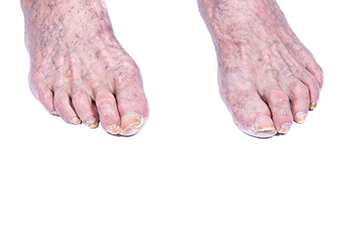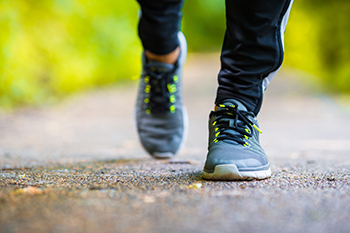
With age comes a myriad of changes to the feet that can affect both their health and functionality. Seniors need to recognize and address common foot problems to maintain mobility and overall well-being. Wearing ill-fitting shoes is a frequent cause of foot problems among older adults. Footwear that lacks proper support and space, can lead to issues like bunions, corns, calluses, and hammertoes. Additionally, the natural aging process brings physical changes, such as decreased padding, flattened arches, stiffened joints, and dry skin, all of which contribute to heightened vulnerability to foot ailments. Underlying health conditions like diabetes, arthritis, neuropathy, poor circulation, and obesity can contribute to foot pain. These ailments increase the risk of complications such as diabetic foot problems and arthritis-related foot deformities. Heel pain, arch problems, tarsal tunnel syndrome, and skin growth are additional problems among seniors. Regular check-ups with a podiatrist not only address existing concerns but also offer proactive measures to maintain healthy feet and sustain an active lifestyle. For personalized care and treatment plans to alleviate foot pain, it is suggested that you schedule an appointment with a podiatrist.
Proper foot care is something many older adults forget to consider. If you have any concerns about your feet and ankles, contact Dr. Mark Gagnon from Advanced Podiatry. Our doctor can provide the care you need to keep you pain-free and on your feet.
The Elderly and Their Feet
As we age we start to notice many changes in our body, but the elder population may not notice them right away. Medical conditions may prevent the elderly to take notice of their foot health right away. Poor vision is a lead contributor to not taking action for the elderly.
Common Conditions
- Neuropathy – can reduce feeling in the feet and can hide many life-threatening medical conditions.
- Reduced flexibility – prevents the ability of proper toenail trimming, and foot cleaning. If left untreated, it may lead to further medical issues.
- Foot sores – amongst the older population can be serious before they are discovered. Some of the problematic conditions they may face are:
- Gouging toenails affecting nearby toe
- Shoes that don’t fit properly
- Pressure sores
- Loss of circulation in legs & feet
- Edema & swelling of feet and ankles
Susceptible Infections
Diabetes and poor circulation can cause general loss of sensitivity over the years, turning a simple cut into a serious issue.
If you have any questions please feel free to contact one of our offices located in Crestwood, Orland Park, and Summit, IL . We offer the newest diagnostic and treatment technologies for all your foot and ankle needs.

Foot drop is a condition characterized by the inability to lift or move the foot and toes. It is characterized by the failure to clear the ground when you take a step, forcing the need to have a marching gait when walking. Foot drop typically results from nerve injury, such as sports injuries, keeping the legs in one position for a long time, or peripheral neuropathy. Certain surgeries, including hip or knee replacements, also may increase the risk of foot drop. Treatment approaches vary, depending on the underlying cause and the duration of the condition. Exercises to strengthen and stretch the muscles of the leg and foot can help to improve mobility. Additionally, braces, splints, or custom orthotic shoe inserts can provide support and maintain proper foot alignment. In some cases, electrical nerve stimulation devices may be employed to aid nerve function. Surgical interventions, such as joint fusion or nerve repair, may be considered for those with permanent impairment. For help with managing foot drop, it is suggested that you schedule an appointment with a podiatrist for a full examination and an accurate diagnosis to determine what the proper treatment is for you.
If you have any concerns about your feet, contact Dr. Mark Gagnon from Advanced Podiatry. Our doctor can provide the care you need to keep you pain-free and on your feet.
Biomechanics in Podiatry
Podiatric biomechanics is a particular sector of specialty podiatry with licensed practitioners who are trained to diagnose and treat conditions affecting the foot, ankle and lower leg. Biomechanics deals with the forces that act against the body, causing an interference with the biological structures. It focuses on the movement of the ankle, the foot and the forces that interact with them.
A History of Biomechanics
- Biomechanics dates back to the BC era in Egypt where evidence of professional foot care has been recorded.
- In 1974, biomechanics gained a higher profile from the studies of Merton Root, who claimed that by changing or controlling the forces between the ankle and the foot, corrections or conditions could be implemented to gain strength and coordination in the area.
Modern technological improvements are based on past theories and therapeutic processes that provide a better understanding of podiatric concepts for biomechanics. Computers can provide accurate information about the forces and patterns of the feet and lower legs.
Understanding biomechanics of the feet can help improve and eliminate pain, stopping further stress to the foot.
If you have any questions please feel free to contact one of our offices located in Crestwood, Orland Park, and Summit, IL . We offer the newest diagnostic and treatment technologies for all your foot and ankle needs.

Clubfoot is a birth defect that affects approximately one in 1,000 infants in the United States. Features of clubfoot include a high arch, inward rotation of the foot, pointed toes, and stiffness, often accompanied by a tight Achilles tendon. Although the precise cause of what is called idiopathic clubfoot remains elusive, genetic factors are presumed to be influential. Diagnosis typically occurs either prenatally through ultrasound or at birth when the foot is found to be rigid. The Ponseti method, named after Dr. Ignatio Ponseti, stands as a highly effective treatment approach, which involves casting, minimal surgery to the Achilles tendon, and bracing. This method has revolutionized clubfoot management, offering an optimistic prognosis for affected children. With early intervention and consistent adherence to the Ponseti method, children with clubfoot can anticipate restored foot function. They can become active in sports and wear regular shoes. For parents confronted with the diagnosis of clubfoot in their child, it is suggested that you schedule an appointment with a podiatrist who can suggest treatment options.
Congenital foot problems require immediate attention to avoid future complications. If you have any concerns, contact Dr. Mark Gagnon of Advanced Podiatry. Our doctor can provide the care you need to keep you pain-free and on your feet.
Congenital foot problems are deformities affecting the feet, toes, and/or ankles that children are born with. Some of these conditions have a genetic cause while others just happen. Some specific foot ailments that children may be born with include clubfeet, polydactyly/macrodactyly, and cleft foot. There are several other foot anomalies that can occur congenitally. What all of these conditions have in common is that a child may experience difficulty walking or performing everyday activities, as well as trouble finding footwear that fits their foot deformity. Some of these conditions are more serious than others. Consulting with a podiatrist as early as possible will help in properly diagnosing a child’s foot condition while getting the necessary treatment underway.
What are Causes of Congenital Foot Problem?
A congenital foot problem is one that happens to a child at birth. These conditions can be caused by a genetic predisposition, developmental or positional abnormalities during gestation, or with no known cause.
What are Symptoms of Congenital Foot Problems?
Symptoms vary by the congenital condition. Symptoms may consist of the following:
- Clubfoot, where tendons are shortened, bones are shaped differently, and the Achilles tendon is tight, causing the foot to point in and down. It is also possible for the soles of the feet to face each other.
- Polydactyly, which usually consists of a nubbin or small lump of tissue without a bone, a toe that is partially formed but has no joints, or an extra toe.
- Vertical talus, where the talus bone forms in the wrong position causing other bones in the foot to line up improperly, the front of the foot to point up, and the bottom of the foot to stiffen, with no arch, and to curve out.
- Tarsal coalition, when there is an abnormal connection of two or more bones in the foot leading to severe, rigid flatfoot.
- Cleft foot, where there are missing toes, a V-shaped cleft, and other anatomical differences.
- Macrodactyly, when the toes are abnormally large due to overgrowth of the underlying bone or soft tissue.
Treatment and Prevention
While there is nothing one can do to prevent congenital foot problems, raising awareness and receiving neonatal screenings are important. Early detection by taking your child to a podiatrist leads to the best outcome possible.
If you have any questions please feel free to contact one of our offices located in Crestwood, Orland Park, and Summit, IL . We offer the newest diagnostic tools and technology to treat your foot and ankle needs.

